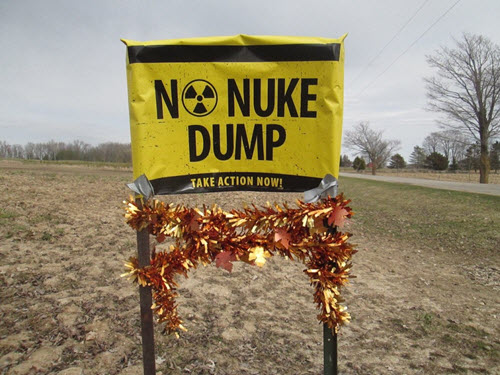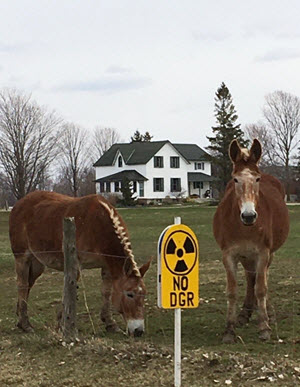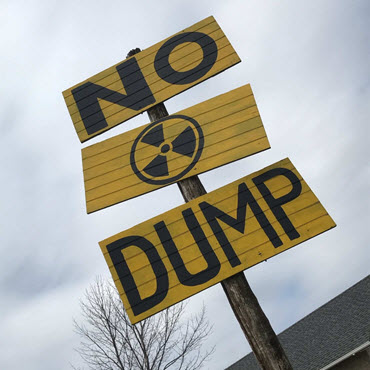Community members clash over the site selection for a high-level nuclear waste deep geologic repository
By Jackie Clark
Staff Writer
Farms.com
South Bruce is an Ontario municipality that boasts “rolling hills, scenic highways and warm-hearted people,” on its website. However, over the last several months, a debate over a plan to build an underground nuclear waste facility has divided the community.
Proposals in Bruce County
Generating nuclear power creates low-, intermediate- and high-level nuclear waste. Low level includes items like mops and rags with short-lived radioactivity. Intermediate-level waste is more “more highly radioactive and consists primarily of used reactor core components, like resins and filters,” explained Becky Smith. She’s the regional communications manager for southwest Ontario for the Nuclear Waste Management Organization (NWMO). Owners, such as the Ontario Power Generation (OPG), are responsible for low and intermediate waste.
Previously, OPG had proposed a plan to store low- and intermediate-level waste in a deep geologic repository (DGR) near Kincardine, Ont. After more than a decade of consultation, the Saugeen Ojibway Nation (SON) members voted not to support the DGR. OPG will honour its 2013 commitment to “not build the DGR at the Bruce site, without the support of SON,” said a Jan. 31 media release.
“High-level waste is used nuclear fuel. When used fuel bundles are removed from the reactor, they are highly radioactive, contain long-lived radioactivity and generate significant heat that requires careful management over very long timeframes,” Smith said. Under the federal Nuclear Fuel Waste Act, the NWMO is responsible for this waste.
“Currently the NWMO is leading a site selection process to identify a single, preferred location for a deep geological repository for used nuclear fuel, to be located in an area with informed and willing hosts. This process is ongoing in two areas, Ignace in northwestern Ontario and South Bruce in southern Ontario,” said Smith.
The DGR would require about 250 acres for the surface facilities and 1,500 acres for the underground repository. “The remaining balance of the site (approximately 1,250 acres) could continue agricultural or other work on some of the land before, during and possibly even after the repository is constructed,” she added.
The consultation process
Site selection for the high-level nuclear waste DGR started in 2010 with a voluntary, community-driven process, Smith said.
“By 2012, 22 communities had expressed interest in learning about the project and exploring their potential to host it. Through increasingly intensive studies and engagement, we gradually narrowed our focus to two potential siting areas,” she added. Since the NWMO made this shortlist, the organization has increased public engagement, including one-on-one conversations and group meetings, on the issue.
As the project advanced, “my concern was to educate myself as to the safety,” Mark Ireland told Farms.com. He’s a third-generation dairy farmer and, since the fall of 2018, has served as a councillor in South Bruce.
NWMO representatives “have made numerous presentations. … They have the community liaison committee, and their responsibility has been education. So, they’ve brought in numerous speakers to speak to that safety aspect,” he explained.
“I think that the people who have accessed that education … were satisfied. They probably left with some questions, (however,) so it’s an ongoing process for people to become educated.”
But other residents have not found the community engagement to be satisfactory.
After understanding that the selection process was becoming more serious and down to two communities, “we started to attend what they call information meetings. We just found that nobody had any answers to any of the questions we asked. It always seemed like, whatever questions we asked, the right person to answer them wasn’t there,” Michelle Stein, a sheep and beef farmer in South Bruce, told Farms.com.
She also attended a visioning workshop where facilitators allowed participants to write questions down. But “the main purpose of the meeting was to find out how we would spend the money that was going to be raining from heaven if we agreed to let this project come here. And (workshop organizers) also told me that nobody had any idea of where (the DGR) was actually going to be if it did come to the municipality,” Stein said.
“The next day, there was an announcement in the newspapers that (the NWMO) had purchased or optioned 1,300 acres next to my farm.”
Matthew Grant, another concerned member of the South Bruce community, is in a similar situation.
“One of the farms that (the NWMO) has entered into an agreement upon is immediately adjacent to our family farm that my mom and dad still live on,” he told Farms.com. The selection process has not been entirely clear and transparent, he said.
Seeking more information, Stein “made an appointment to go in and talk to (NWMO officials) at the office,” she said. She had concerns about her farm operation. “We asked them ‘What happens if this project affects our water?’ …. (The representative’s) answer to us was that it was a really good question but (the NWMO) wasn’t at the point of being able to answer it.”
After that meeting, Stein started conducting research and attended another public information session.
“I tried to ask some questions but you weren’t allowed to ask questions. So, (the session organizers) adjourned the meeting. After that, neighbours invited a bunch of us to come to their kitchen to discuss what we should maybe do about this issue. We had about 45 people show up at their house that first day,” she said. “The response has been overwhelming.”
Some members of the South Bruce community feel as if they’ve been left out of the conversation.
“There’s been land acquired and we’re down to two communities. I think that’s what’s made it very real for the residents of South Bruce and some of the surrounding communities,” Grant said.
Safety concerns
“Our top priority at the NWMO is the protection of people and the environment. Implementation of a deep geological repository falls within federal jurisdiction and will be subject to the Canadian Nuclear Safety Commission’s comprehensive licensing system. It covers the entire lifecycle of the repository, from site preparation, to construction, operation and decommissioning. The project can only go ahead if it is demonstrated to be safe through an open and transparent regulatory process,” explained Smith.
“A series of engineered and natural barriers will work together to contain and isolate used nuclear fuel from the environment. The multiple barrier approach includes the waste form, container, sealing materials, and the host rock. The system is designed such that the failure of one component would not jeopardize the safety of the containment system as a whole,” she said.
The NWMO would enact an ongoing monitoring program for ground and surface water, radiation, air quality, and other measurables.
However, residents still have concerns about a high-level nuclear waste DGR in their community.
“The folks in South Bruce, who I would consider the key and primary stakeholders in all of this, are concerned about … health and safety, and the stigma that will be attached to” nuclear waste, Grant explained. These stakeholders are also worried about “the value of land and businesses in the immediate vicinity as well as along the transportation routes from where the high-level nuclear waste is currently stored into the community.”
“The water issue is probably one of the biggest,” Stein said.
She pointed to a report published by the NWMO.
“Containers for the disposal of used fuel are typically designed for a very long life. When the containers eventually fail by corrosion as a result of ground water ingress into the repository, waste constituents can migrate out of the disposal facility and enter the biosphere,” said the NWMO Background Papers 6 (Technical methods: Status of storage, disposal, and transportation containers for the management of used nuclear fuel, written by Aamir Husain and Kwansik Choi from Kinectrics Inc.). Groundwater composition is one of the factors that affects container corrosion, the Husain and Choi reported in the paper.
“Ultimately, the repository will become fully saturated and the ground water will induce local corrosion. To minimize water-related impacts, one option is to site a repository in an arid desert region,” the report said.
Given this information, “I’m very concerned that our groundwater is going to be damaged,” said Stein.
Arid desert regions “may not be a practical option for Canada because such regions are far removed from the locations where used fuel is generated,” the report acknowledged. “However, geological disposal within the stable granitic rock of the Canadian Shield, at a depth of 500 to 1,000 m, is considered to be generally acceptable for isolation of the Canadian used fuel. Alternately, the repository may be located within a shallower clay layer in the sedimentary rock sequences overlying the granitic rock.”
Grant also raised the concern that the rock material of South Bruce, which is limestone, is a sedimentary formation.
“Globally, the nuclear community primarily speaks of DGRs being placed in granite or crystalline geologic structures. So, (the South Bruce proposal) seems to be a relatively recent departure from the science around the type of geology that we would bury this waste in,” Grant said.
The NWMO will study the local rock material further.
“Over the coming years, we will collect additional information about the geology through our borehole drilling and testing program that will provide more information about whether the geology at the potential repository site could be a safe place. The findings from the borehole drilling program will be integrated into an understanding of the subsurface conditions at the potential repository site. These results will be shared with an expert group for peer review as well as the community,” Smith said.
“A well-designed repository will result in acceptable future impacts to both humans and other biota. Typically, releases of radionuclides to the biosphere are not expected to occur for time periods in the order of tens of thousands of years,” the NWMO technical paper said. A radionuclide is an atom with excess nuclear energy, which can emit radiation as it breaks down.
Some community members are uncomfortable with the level of uncertainty over a long timeline.
“We all know that, when humans are involved, mistakes can and will happen. This will be an unprecedented movement of high-level nuclear waste material,” Grant said. “This is such an untested and unprecedented project. So, we better be really sure, before we start buying nuclear waste, that it’s going to be a solid solution.”
Community concerns
Beyond safety issues, community members have other concerns about activities associated with a nuclear DGR.
Building the facility will involve dust, noise vibrations, extra traffic, and removed rock, Stein said. “In my opinion, (the facility) is not a great thing to go and stick on top of prime agricultural farmland.”
Residents also worry about the associated stigma.
“We milk sheep but we also have lambs that go to market,” she said. A representative from a butcher shop in Toronto has already said, if the DGR went ahead, the shop could no longer accept the Stein family’s lambs. Consumers wouldn’t like the thought of meat coming from a nuclear waste storage region.
The siting process has disrupted families’ property values and farm planning and decision making.
“We’ve invested 25 years into this property,” Stein said. And “people aren’t interested in moving into an area that might have all of Canada’s high-level nuclear waste.”
If the project goes ahead, Grant will not follow through on his plan to return to live in South Bruce.
“Our whole farm transition plan has been blown up, at least for the moment,” he said. And, “for the folks in the community, (the DGR proposal) has been such a dividing force.”
Stein agreed.
“There’s been people who we have farmed with for years and I would say we are no longer friends. There’s definite tension there. On the other hand, we’ve made a bunch of new friends. But (the situation) is definitely tearing the community apart.”
A Change.org petition against the DGR has accumulated over 1,300 signatures as of early May, and community members have formed a group called Nuclear Tanks No Thanks to counter the NWMO’s plans.



Stein has erected signs on her property in opposition of the DGR proposal. She and some other residents distributed painted and printed signs to interested community members.
Support for the project
Despite the controversy, some community members in South Bruce see good opportunities for the municipality in the NWMO’s proposal.
“The obvious benefit is the economic benefit, the jobs that are created. As with most small communities across Ontario, we struggle to keep our infrastructure – our arenas, our schools and our churches – in place and to keep them functioning,” says Ireland. “Jobs will keep people in our area.”
Residents recognize that communities need electricity.
“Our society and our economy use a lot of electrical energy. If we’re going to continue to have the standard of living that we enjoy, we’re going to continue to use electrical energy and it needs to be produced somehow, somewhere,” Ireland explained. “If you’re going to use the electrical energy, then you have some responsibility for the waste that’s generated.”
For a long time, humans have burned fossil fuels and are now dealing with the consequences of the carbon dioxide emissions, he said.
If society is going to use nuclear power, nuclear experts and communities need a responsible plan for spent nuclear fuel to avoid negative consequences.
The NWMO “has invited the public on numerous bus tours to its research facility and to the waste facility where the spent fuel is stored right now at the Bruce,” Ireland said. “Is that where that spent fuel should spend the rest of its life, in a big warehouse? I think that’s a question for people who turn their lights on.”
What’s to come
“The municipality is forming a committee to work with the community to analyze the socio-economic impact. That’s part of the process,” Ireland said. He hopes to “open dialogue with people who are concerned about the perceived negative aspect of (the DGR).
“The municipal council still seeks more information to determine whether the municipality is a willing host. That’s a point that the NWMO representatives have said from the start – that they will only locate the DGR in an informed and willing community. I believe there’s still work to be done to have that informed community,” he added.
Smith agreed.
“A key component of Canada’s plan is willingness – the project will only proceed in an area with informed and willing hosts working in partnership to implement the project. This includes both municipal and Indigenous communities,” she said. “The NWMO expects to identify a single, preferred location for a deep geological repository by 2023. Construction is expected to begin in 2032 and we hope to be in operation by 2043.”
South Bruce officials have yet to determine if the municipality is a willing host, Robert Buckle said in a letter to the editor in the Walkerton Herald Times on May 7. He’s the mayor of South Bruce.
“All decisions related to the site selection process will be made by the municipal council with input from the community liaison committee,” he said.
“We’d really like council to give us a chance to have a referendum and answer the question. (Then,) we can carry on from there, because being in limbo makes it really hard to plan for anything,” Stein said. “All your decisions are up in the air.”
The community needs to be involved in the decision making.
“It cannot be left to council. To me, it just doesn’t seem right for six council members and the mayor to make a decision this big when it affects everybody,” she said.
SkyF\iStock\Getty Images Plus photo